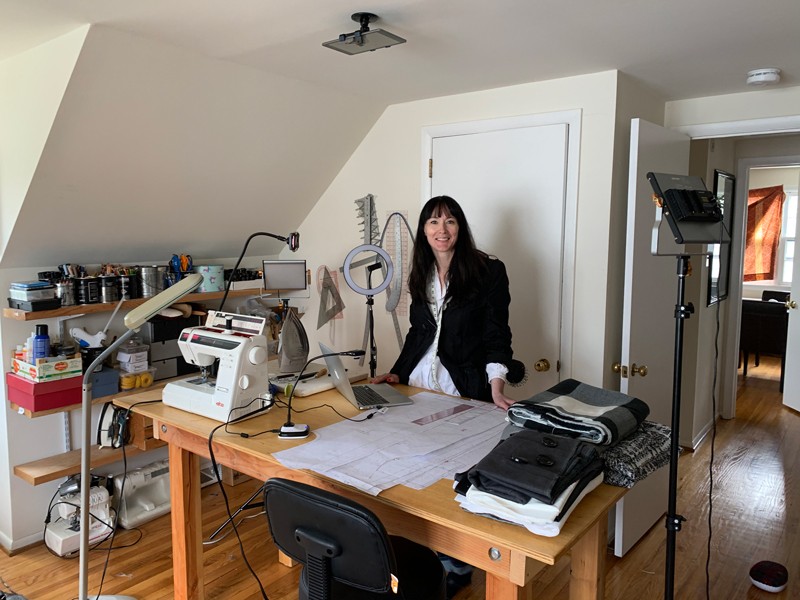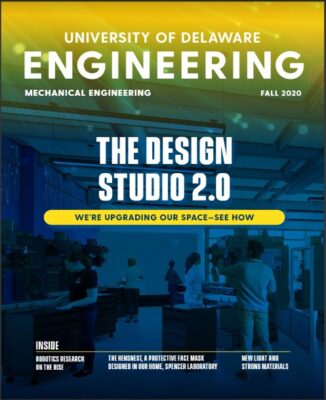University-wide team effort brings all but two of 6,422 course sections online in just two weeks
The coronavirus COVID-19 health crisis forced universities to adjust and adapt quickly to an unprecedented situation. One of the biggest questions was how fast, and how effectively, they would be able to move the college classroom experience to the virtual setting.
At the University of Delaware, the answer was very quickly, and very effectively.
Thanks to exceptional coordination and communication among administration, faculty, UD Information Technologies (specifically Academic Technology Services), the Center for Teaching and Assessment of Learning), deans and department heads of colleges and many other entities and individuals, UD was able to move all but two of 6,422 course sections online in just two weeks between March 16 and the start of classes on March 30.
Provost Robin Morgan hailed the creative mindset of faculty and leadership across campus who facilitated the transition.
“I have never been prouder of the University of Delaware,” Morgan said. “For many of our faculty, moving to online course delivery was easy. For others, this presented a real challenge — not only in terms of learning new technology, but in figuring out how to deliver courses that don’t lend themselves easily to an online format. I have been truly energized by everyone’s willingness to help each other and to make sincere efforts to connect with our students.”
UD-IT built the tracks on which this train would run. The Academic Technology Services wing of IT might be called the steel beam of that track. Sharon Pitt, vice president of IT, singled out Paul Rickards and Paul Hyde for their contributions, which included training volunteers across the UD-IT team in first-level learning technology support to handle the expected deluge of calls from faculty and students on the first two days of online classes and working with faculty members who needed help with the use of online tools.
“The UD-IT team has performed astonishing work, day and night,” Pitt said. “They have embraced unexpected change and moved quickly to ensure new solutions. Each faculty member and each student served by the University of Delaware should have access to any tool required for academic success.”
At the same time, while the infrastructure is in place, the transition has been challenging for many students, said Lynn Okagaki, deputy provost for academic affairs.
“Learning from home — perhaps with siblings and parents all needing to use the same computer — presents many challenges,” Okagaki said.
The University has made some adjustments in response to this and other trials students might encounter, including a modified pass/no credit grading option. The Office of Academic Enrichment has resources, tips for learning in the online environment and free virtual drop-in tutoring sessions. Student Life has launched a Virtual Hub, which is a central place for students to find student wellbeing resources such as counseling, food, housing, or technology insecurity in these difficult and rapidly changing times.
Faculty has received ample assistance as well. Rickards said preparations began in early March with a workshop series in Faculty Commons on course continuity topics such as recording your own video content, using the University’s learning management system, using a video conferencing tool to deliver live courses or office hours and using tools to perform assessments. The on-campus sessions were supplemented by a live video conferencing component. Sessions were well attended both in Faculty Commons and online by all those involved in teaching: faculty, graduate students in a teaching role and staff who support teaching and learning at a college level. By the time courses re-launched a few weeks later, 23 workshops had been provided for 1,439 registrants.
The list of rescues and success stories is almost as endless as the internet. Jung-Youn Lee, a professor of plant and soil sciences, went into a panic when she wasn’t able to connect her desktop to Wi-Fi or activate the microphone. Her SOS signal to the department admin and IT staff resulted in a flurry of emails that led to equipment being shipped to her home.
Among that equipment was a headset that helped Lee overcome her anxiety about having an accent that she worried might not translate well to her students online.
“My first class was successful — my students had no background noise issue, and could hear me clearly,” Lee said. “In short, everyone was swift in helping in my department and college, which reduced my anxiety so I could focus my attention fully on adjusting assignments, course content and assessment and connecting more with my students in a new way.”
The flexibility and ingenuity of UD’s faculty was crucial to smooth migration to online classes.
In the Department of Mechanical Engineering, a “buddy system” was established to pair faculty more experienced with online learning with those who were not,” said Jenni Buckley, associate professor of mechanical engineering. Led by chair Ajay Prasad, the department also repurposed a department-wide teaching resources Canvas page as an open forum where faculty could share tips, tutorials and examples.
“Both of these resources were really popular because they made faculty who might have struggled a bit feel like they weren’t alone and there were trusted peers who could help,” Buckley said. “It has been really amazing to Ajay and me to see how our more senior faculty are stepping up to the plate when it comes to adopting new technologies and teaching techniques.”
The most pressing concern across the board in mechanical engineering — and across most of the engineering disciplines — was how to administer long-form written exams. Professor Suresh Advani came up with a “hack” of proctoring using Zoom that Buckley and a team of faculty were able to scale into a protocol that could be used in classes.
Laura Mina, associate conservator of textiles and head of Textile Lab for UD’s Winterthur Program, built fabric packs for students to use at home to examine textile construction.
Prior to the outbreak, business students in marketing professor Julia Bayuk’s classes were working with English Language Institute students to create plans of action for their international marketing projects. Once the move to online began, the students quickly transitioned to doing their group work remotely and their presentations online via Zoom.
Psychological and Brain Sciences Professor Agnes Ly used videos early in the process to welcome students, explain the new mindset, understand the changes and stay motivated and mentally healthy.
“Our faculty have done an amazing job to quickly transition from face-to-face instruction to a virtual environment,” Okagaki said. “They have been flexible, creative and collaborative. I also want to commend our students who have had to quickly adjust to new conditions. This is a great example of what Blue Hens can accomplish by working together.”
For courses in departments like fashion and apparel studies, it’s almost impossible to provide hands-on instruction when you can’t be there in person. Instructor Katya Roelse found a workaround, setting up a small home studio for her course called “Apparel Design by Flat Pattern,” where she can record demonstrations and possibly hold them live. The course is a highly technical one where students need to design, pattern and sew a tailored jacket.
“Recording these demonstrations is something I’ve been wanting to do for a while now to save class time and basically flip the classroom so now I’m doing it,” Roelse said. “There’s always that moment when you’re not sure if the technology will come together for you, but right now I’m having fun and trying to prepare for the unknown.”
The lift on the technical side was a heavy one. William Totten, who is the enterprise architect for Enterprise Systems and Cloud Services for UD-IT, was responsible for arranging and directing solutions to provide student access to the software they need to perform classwork. The challenge was that students in different majors needed different software. Those doing statistics needed access to programs like SAS and Minitab, whereas engineers needed Solidworks to create three-dimensional models. Options for students include downloading software from UDeploy, accessing a virtual desktop and using an existing UD computer lab remotely.
The Virtual Desktop option, offered by Rich Duggan, director of college computing operations for the College of Arts and Sciences, created what appears to be its own computer running in a server farm on campus. These Virtual Desktops are loaded with about 50 of the most important and well used software packages by our students. After connecting remotely to these Virtual Desktops, the students can use this software and it will work as if it was running locally, in their house. To leverage and expand this existing solution, Totten had to work closely with vendors, Duggan and Pitt to extend the CAS Virtual Desktop infrastructure to handle 600 simultaneous students across UD.
Even with the technical infrastructure in place, the migration would not have taken hold without Okagaki’s devotion to course continuity. Matt Kinservik, vice provost for faculty affairs, singled out Okagaki for those efforts as well as for serving as the main point of contact with the deans, collecting information on the readiness of thousands of faculty and students so that classes could be moved to distance learning formats.
As chair of the Task Force on Emergency Academic Regulations, Okagaki was responsible for helping to quickly develop the new emergency rules on grading and course withdrawals. University policies in the Faculty Handbook do not address the challenges of a long-term disruption like the COVID-19 pandemic.
“This situation required a lot of improvisation and quick responses to a quickly evolving crisis,” Kinservik said. “In that sense, it sent us into territory beyond our policies and past practices, so we really had to work together (administration, Faculty Senate, AAUP, staff and student leaders) to develop smart, safe, humane responses to a situation none of us has been through before. I really value the trust and collaboration of so many people as we figured this out.”
So many entities had to communicate and coordinate to make this happen. But the most important communication had to take place where it matters most — in the now-virtual classroom, between teacher and student.
That was one of the main points of focus for the faculty, grad students and adjuncts who teach English 110, said Christine Cucciarre, who teaches and also oversees these first-year writing classes.
English 110 is the smallest class that students take in their first year — there are usually about 20 in a class — and it’s the only class all students have to take. Cucciarre said teachers have been using Zoom’s breakout group function to enhance the intimacy so that they can interact with even smaller groups of students.
The return to classes, even if it was online, felt like “a great coming together,” Cucciarre said.
“There was a whole sense of community in a class where communication is so central,” Cucciarre said. “Over and over again I heard how good that felt.”
| Photo courtesy of Katya Roelse


